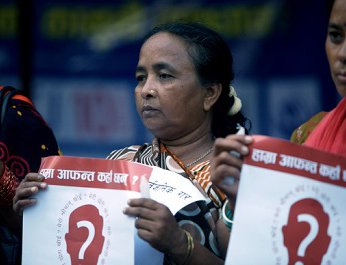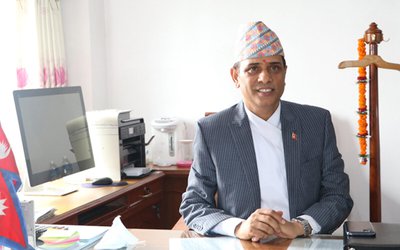
Ram Krishna Chaudhary, a resident of Banke, held the card with the photograph of her son, Bhuban, who disappeared ten years ago.
Ram Kumar Bhandari is yet to find his father Tej Bahadur Bhandari when he was on his way to the CDO office in Besisahar on 31 December 2001 when a group of armed security personnel arrested, blind-folded, and tortured him on the street in broad daylight.
Kumari Rai, 62, a resident of Bhojpur district has knocked all doors of human rights offices, government offices and leaders of political parties. However, all of her efforts went in vain while searching for her husband who disappeared in 2002.
As in the past, along with the family members of victims, Kumari marched on the streets of Kathmandu, marking the International Day of the Victims of Enforced Disappearance this year.
“Although it is no more than a ritual, I am coming to take part in hopes to know the whereabouts of my husband,” said Kumari. “I am confident that I will get justice.”
On 21 November 2006, after signing the Comprehensive Peace Agreement, CPA, between Nepal government (the Seven Party Alliance) and the Communist Party of Nepal (Maoist), that officially ended the 10-year conflict, both sides agreed to “make public within 60 days of the signing of the agreement the correct and full names and addresses of the people who ‘disappeared’ or were killed during the conflict and convey such details to the family members. They also agreed to create a truth and reconciliation commission in order to investigate serious violations of human rights during the conflict, including enforced disappearances.
However, little has been done to allow the families of the disappeared to find truth, justice and realize the right to an effective remedy even after years. The Parliament has recently passed a law that provides procedures to form a Commission of Inquiry on Disappearances (CoI) and Truth Commission but it contains a provision on amnesty.
According to National Network of Families of Disappeared and Missing Nepal (NEFAD), the government and rebels all want to cover the trauma of disappearance and lost.
According to an estimate, more than 1,300 people are thought to have disappeared during the armed conflict in Nepal between 1996 and 2006. To date, not a single person suspected of criminal responsibility for serious human rights violations or crimes under international law committed during the conflict has been brought to justice in a criminal court.
Amnesty International Call
“The failure of the Nepali authorities to bring those responsible for the disappearance of five men more than a decade ago to justice is symptomatic of their willful inaction in such cases," Amnesty International said in a press release ahead of the International Day of the Victims of Enforced Disappearances on 30 August. “To date, not a single person suspected of criminal responsibility for serious human rights violations or crimes under international law committed during the conflict has been brought to justice in a criminal court.
“The Nepali authorities need to end the excuses and instead deliver justice for the victims and families of the disappeared,” said Richard Bennett, Asia Pacific Director at Amnesty International.
Every year on the International Day of the Disappeared, victims’ families in Nepal gather to demand that Nepal’s government reveal the fate and whereabouts of victims of enforced disappearance and prosecute those suspected of committing them.
Forensic and DNA analysis completed earlier this year identified remains exhumed from gravesites near Janakpur, Danusha District as those of five men that were disappeared by security forces in 2003.
The analysis found that the “Dhanusha Five” had been blindfolded, shot at close range and buried. Ballistic analysis confirmed that bullets found at the burial site corresponded with ammunition only used by the Nepal Army at the time.
Sanjeev Kumar Karna and a group of ten friends were beaten and arrested by a group of army and police personnel while on a picnic in Janakpur on 8 October 2003. Five of these young people, including Sanjeev Kumar Karna, were never seen alive again by their families.
In July 2014, more than a decade after the murders, Nepali authorities returned the remains to surviving family members. Despite the forensic evidence that the five youths were victims of extrajudicial execution, suspects - including high ranking police and military personnel - remain free, some in positions of authority. Police investigations into the case appear to have stalled.
Sanjeev’s father, Jai Kishore Labh, dedicated the remainder of his life to seeking truth and justice for his missing son and his friends. He died in 2010 without an answer.
Last week, an Amnesty International delegation met with surviving parents of the “Dhanusha Five” who reiterated their calls for justice.
“There must be no whitewash when it comes to investigating and bringing to justice those responsible for the disappearance and killing of these five men,” said Richard Bennett. “The authorities are dragging their feet on these investigations. It seems they appear content to push this case and others like it to the proposed Truth and Reconciliation Commission.”
The Truth and Reconciliation Act, which was passed by Nepal’s parliament in April established two commissions, a Truth and Reconciliation Commission and a Commission on Investigation of Disappeared Persons (CIDP). It is appropriate that the CIDP, once operational would investigate this important case, but that process should not hold up the criminal justice procedure.
The Truth and Reconciliation Commission law, which remains under review by the Supreme Court, does not meet Nepal’s obligations to provide remedies, including full and effective reparation, to victims.
As it stands, the proposed Truth and Reconciliation Commission would be deeply flawed particularly as it would have the power to grant amnesties to those suspected of committing crimes under international law. This could include those responsible for the “Dhanusha Five” enforced disappearances.
“These cases must be independently investigated and those responsible brought to justice. There is ample evidence in the 'Dhanusha Five' case for it to proceed to a criminal investigation and prompt prosecution of suspects in fair trials,” said Richard Bennett.
According to International Committee of the Red Cross, the fate of the people who went missing during the decade-long conflict was still unclear — even after eight years since the peace process began.
The ICRC and Nepal Red Cross Society have made public a report ‘Missing persons in Nepal: Updated List 2014’ which has names of 1,347 people who went missing during Nepal’s decade long internal armed conflict (1996-2006).
Missing persons in Nepal: Updated List 2014 is the seventh edition of the list of missing persons. Jointly unveiled by Minister for Peace and Reconstruction Narahari Acharya, the list was made public before members of families of missing persons and other distinguished guests, government officials, members of the armed and security forces, human rights organizations, civil society organizations, media and Red Cross.
“According to the ICRC, 3,777 individuals disappeared during the armed conflict. Among them, 1,347 — about one in three — are still missing,” said Dragana Kojic, head of the ICRC delegation in Kathmandu said. “The aim of this publication is to bring public recognition to the families of missing persons in Nepal and to highlight their sufferings and their needs,” said Kojic, adding: “It also constitutes an appeal to the Nepal government and all former parties to the conflict to clarify the fate and, whenever possible, the whereabouts of the missing and to ensure that all such families are included in government support program.”
“The NRCS acts as the bridge between the ICRC and the families while raising the issue of missing persons among the concerned authorities,” said Dev Ratna Dhakhwa, general Secretary of the NRCS. “They have been expanding their capacities from the central to the district levels.”
Although the peace process is closer to end with integration of Maoist combatants and promulgation of new acts, families of disappeared are yet to find relief from the trauma.
- TANAHU HYDROPOWER PROEJCT: A Significant Achievement
- Apr 15, 2024
- AMBASSADOR HANAN GODAR: Sharing Pain With A Nepali Family
- Mar 30, 2024
- VISIT OF KfW AND EIB TO NEPAL : Mission Matters
- Mar 25, 2024
- NEPAL BRITAIN SOCIETY: Pratima Pande's Leadership
- Mar 24, 2024
- NEPAL ARMY DAY: Time To Recall Glory
- Mar 15, 2024
















